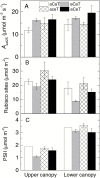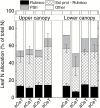Linking photosynthesis and leaf N allocation under future elevated CO2 and climate warming in Eucalyptus globulus
- PMID: 28064178
- PMCID: PMC5444472
- DOI: 10.1093/jxb/erw484
Linking photosynthesis and leaf N allocation under future elevated CO2 and climate warming in Eucalyptus globulus
Abstract
Leaf-level photosynthetic processes and their environmental dependencies are critical for estimating CO2 uptake from the atmosphere. These estimates use biochemical-based models of photosynthesis that require accurate Rubisco kinetics. We investigated the effects of canopy position, elevated atmospheric CO2 [eC; ambient CO2 (aC)+240 ppm] and elevated air temperature (eT; ambient temperature (aT)+3 °C) on Rubisco content and activity together with the relationship between leaf N and Vcmax (maximal Rubisco carboxylation rate) of 7 m tall, soil-grown Eucalyptus globulus trees. The kinetics of E. globulus and tobacco Rubisco at 25 °C were similar. In vitro estimates of Vcmax derived from measures of E. globulus Rubisco content and kinetics were consistent, although slightly lower, than the in vivo rates extrapolated from gas exchange. In E. globulus, the fraction of N invested in Rubisco was substantially lower than for crop species and varied with treatments. Photosynthetic acclimation of E. globulus leaves to eC was underpinned by reduced leaf N and Rubisco contents; the opposite occurred in response to eT coinciding with growth resumption in spring. Our findings highlight the adaptive capacity of this key forest species to allocate leaf N flexibly to Rubisco and other photosynthetic proteins across differing canopy positions in response to future, warmer and elevated [CO2] climates.
Keywords: Canopy position; Eucalyptus globulus; Rubisco kinetics; Vcmax; elevated CO2 and temperature; photosynthesis; whole-tree chambers..
© The Author 2017. Published by Oxford University Press on behalf of the Society for Experimental Biology.
Figures




Similar articles
-
Photosynthesis of temperate Eucalyptus globulus trees outside their native range has limited adjustment to elevated CO2 and climate warming.Glob Chang Biol. 2013 Dec;19(12):3790-807. doi: 10.1111/gcb.12314. Epub 2013 Oct 11. Glob Chang Biol. 2013. PMID: 23824839
-
Photosynthetic enhancement by elevated CO₂ depends on seasonal temperatures for warmed and non-warmed Eucalyptus globulus trees.Tree Physiol. 2015 Nov;35(11):1249-63. doi: 10.1093/treephys/tpv110. Epub 2015 Oct 23. Tree Physiol. 2015. PMID: 26496960
-
Strong thermal acclimation of photosynthesis in tropical and temperate wet-forest tree species: the importance of altered Rubisco content.Glob Chang Biol. 2017 Jul;23(7):2783-2800. doi: 10.1111/gcb.13566. Epub 2017 Jan 3. Glob Chang Biol. 2017. PMID: 27859952
-
Photosynthesis, plant growth and N allocation in transgenic rice plants with decreased Rubisco under CO2 enrichment.J Exp Bot. 2000 Feb;51 Spec No:383-9. doi: 10.1093/jexbot/51.suppl_1.383. J Exp Bot. 2000. PMID: 10938846 Review.
-
The heat is on: scaling improvements in photosynthetic thermal tolerance from the leaf to canopy to predict crop yields in a changing climate.Philos Trans R Soc Lond B Biol Sci. 2025 May 29;380(1927):20240235. doi: 10.1098/rstb.2024.0235. Epub 2025 May 29. Philos Trans R Soc Lond B Biol Sci. 2025. PMID: 40439311 Free PMC article. Review.
Cited by
-
Exploring the optimum nitrogen partitioning to predict the acclimation of C3 leaf photosynthesis to varying growth conditions.J Exp Bot. 2019 Apr 29;70(9):2435-2447. doi: 10.1093/jxb/ery277. J Exp Bot. 2019. PMID: 30053195 Free PMC article.
-
Does the response of Rubisco and photosynthesis to elevated [CO2] change with unfavourable environmental conditions?J Exp Bot. 2024 Dec 4;75(22):7351-7364. doi: 10.1093/jxb/erae379. J Exp Bot. 2024. PMID: 39264212 Free PMC article.
-
Variation, coordination, and trade-offs between needle structures and photosynthetic-related traits across five Picea species: consequences on plant growth.BMC Plant Biol. 2022 May 17;22(1):242. doi: 10.1186/s12870-022-03593-x. BMC Plant Biol. 2022. PMID: 35581540 Free PMC article.
-
Asynchronous nitrogen supply and demand produce nonlinear plant allocation responses to warming and elevated CO2.Proc Natl Acad Sci U S A. 2019 Oct 22;116(43):21623-21628. doi: 10.1073/pnas.1904990116. Epub 2019 Oct 7. Proc Natl Acad Sci U S A. 2019. PMID: 31591204 Free PMC article.
-
The optimal CO2 concentrations for the growth of three perennial grass species.BMC Plant Biol. 2018 Feb 5;18(1):27. doi: 10.1186/s12870-018-1243-3. BMC Plant Biol. 2018. PMID: 29402224 Free PMC article.
References
-
- Adam NR, Wall GW, Kimball BA, et al. 2000. Acclimation response of spring wheat in a free-air CO(2) enrichment (FACE) atmosphere with variable soil nitrogen regimes. 1. Leaf position and phenology determine acclimation response. Photosynthesis Research 66, 65–77. - PubMed
-
- Ainsworth EA, Rogers A. 2007. The response of photosynthesis and stomatal conductance to rising [CO2]: mechanisms and environmental interactions. Plant, Cell and Environment 30, 258–270. - PubMed
-
- Barton CVM, Ellsworth DS, Medlyn BE, et al. 2010. Whole-tree chambers for elevated atmospheric CO2 experimentation and tree scale flux measurements in south-eastern Australia: the Hawkesbury Forest Experiment. Agricultural and Forest Meteorology 150, 941–951.
-
- Battaglia M, Beadle C, Loughhead S. 1996. Photosynthetic temperature responses of Eucalyptus globulus and Eucalyptus nitens. Tree Physiology 16, 81–89. - PubMed
Publication types
MeSH terms
Substances
LinkOut - more resources
Full Text Sources
Other Literature Sources
Medical

